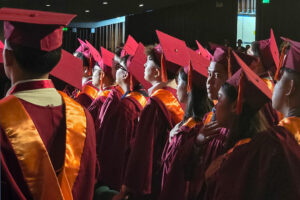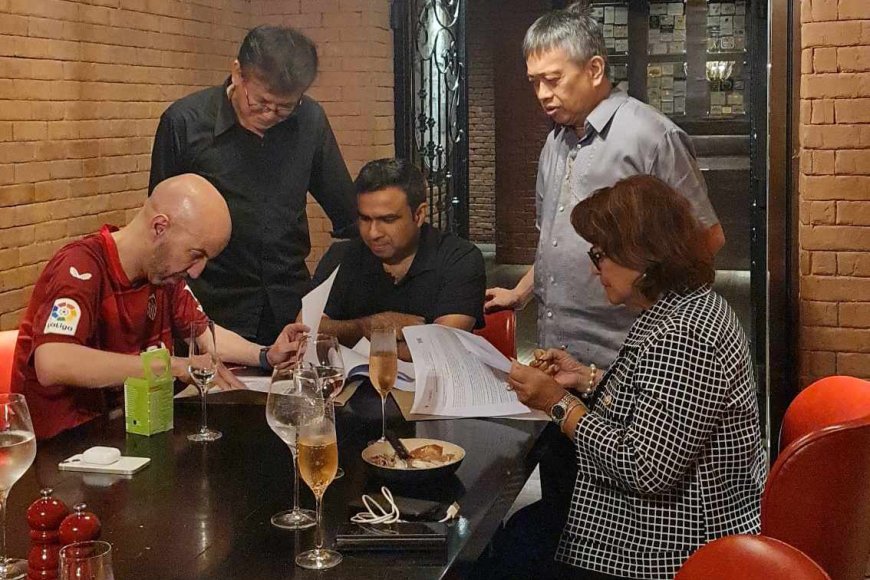PHL slumps to near bottom of global talent index
THE PHILIPPINES slumped to the near bottom of an annual global ranking of countries’ ability to attract and retain a skilled workforce, a report by the Institute for Management Development (IMD) World Competitiveness Center showed.

By Justine Irish D. Tabile, Reporter
THE PHILIPPINES slumped to the near bottom of an annual global ranking of countries’ ability to attract and retain a skilled workforce, a report by the Institute for Management Development (IMD) World Competitiveness Center showed.
In the IMD’s World Talent Ranking (WTR) 2024, the Philippines slipped three spots to 63rd out of 67 countries, from 60th out of 64 economies last year. This is the country’s worst ranking from as early as 2005.
The Philippines’ talent competitiveness continued to fall behind Asia-Pacific neighbors. It ranked 13th out of 14 Asia-Pacific countries, better only than Mongolia.
Singapore was the highest-ranking economy in the Asia-Pacific, as it finished second overall. It was followed by Hong Kong (9th), Australia (14th), Taiwan (18th), South Korea (26th), Malaysia (33rd), China (38th), New Zealand (39th), Japan (43rd), Indonesia (46th) and Thailand (47th), and India (58th).
The talent index was again dominated by European economies led by Switzerland (1st overall), Luxembourg (3rd), Sweden (4th), and Denmark (5th).
The WTR rankings are based on three factors: “appeal,” or the extent to which an economy attracts foreign talent and retains local talent; “investment and development,” which refers to the measurement of resources allotted to develop a homegrown workforce; and “readiness,” or the quality of the skills in a country’s talent pool.
José Caballero, a senior economist at IMD World Competitiveness Center, said in an e-mail interview that the drop in the Philippines’ talent ranking was due to the decline in the investment and development and readiness factors.
“At the indicator level, the main aspect affecting its performance in investment and development is the inadequate implementation of apprenticeship programs and the limited prioritization of employee training by the private sector,” he said.
The Philippines had the lowest ranking in investment and development, falling to 64th this year from 62nd last year. This was due to a significant drop in the ranking for apprenticeships and employee training.
The Philippines also ranked among the lowest in terms of public expenditure on education per student (63rd) and pupil-teacher ratio for primary (60th) and secondary (63rd) education.
On the readiness factor, the country slipped a spot to 52nd place.
“In terms of readiness, there is a general decline in all measures of the impact of the country’s talent development efforts,” Mr. Caballero said. “There is also a decline in the prioritization of talent attraction and retention among companies (57th) and workers’ motivation (47th), which feed into brain drain (54th). The latter is one of the key drivers of talent readiness.”
The low scores of 15-year Filipino students in the Programme for International Student Assessment (PISA) are one of the Philippines’ top weaknesses. Filipino students were among the world’s weakest in math, reading and science, according to the 2022 PISA. The Philippines ranked 77th out of 81 countries and performed worse than the global average in all categories.
Mr. Caballero said that the country’s low investment in education and the quality of the system are fundamental to understanding why is it lagging behind its regional counterparts.
On appeal, the Philippines went up a notch to 54th spot, as it performed well in terms of cost-of-living (20th) and collected personal income tax (20th). However, it ranked low in terms of quality of life (57th).
“The Philippines’ appeal is also a factor. Although it has a relatively strong cost of living, its quality of life is lacking, as is its performance in measures of institutional strength, which are crucial for attracting highly qualified talent,” Mr. Caballero added.
To improve, he said that the country must revisit its overall talent development strategy, which will help streamline its investment in the education sector.
“This should be a carefully considered strategy, not a matter of just increasing expenditure, but one that aligns investment with the outcome of the system, that is, the skills and competencies that the Philippines’ economy needs to perform efficiently,” he added.
Jose Enrique “Sonny” A. Africa, executive director of think tank IBON Foundation, said that the country lags in talent competitiveness due to its failure to prioritize education and public health.
“Asia-Pacific countries like Japan, South Korea, Taiwan, Singapore, Malaysia, and Thailand have done better because they have focused on building comprehensive education systems, investing in public health, and different levels of national industrial policy,” Mr. Africa said via Viber.
“In contrast, the Philippines continues to struggle with reckless liberalization, underfunded institutions, and shortsighted economic strategies,” he added.
Mr. Africa said the government can achieve immediate gains by investing more in education, health, and social protection, which will ensure a more capable and productive workforce.
“The government can build more and better public educational infrastructure, ensure universal access to quality education, and improve vocational and technical training,” he said.
Meanwhile, Benjamin B. Velasco, assistant professor at the School of Labor and Industrial Relations at the University of the Philippines Diliman, said that it is not surprising that the country ranks very low in the talent index.
“Many of the indicators for talent are dependent on education, for example, the program for PISA rankings, student-teacher ratios, and the budget for education,” Mr. Velasco said in a Viber message.
“In this objective set of indicators, we do not do well. Our education system is in crisis,” he added.
To improve its education system, Mr. Velasco said that the country will have to increase the budget for public education, improve pay to attract talent to the teaching profession, and provide books, gadgets, and classrooms.
“The private sector should pay more, not less, taxes to increase public revenues. These are hardly original ideas. Many have said this before. It is not that our public officials do not have talent. But they lack the will to just do it. They seem busy in their games of thrones,” he added.
Jamil Paolo S. Francisco, executive director of the Asian Institute of Management Rizalino S. Navarro Policy Center for Competitiveness, said the Philippines lags behind its peers due to its low public expenditure on education as a percentage to gross domestic product and on a per student level.
“Our relatively weaker investment in human capital development has negative implications for the future readiness of our workforce. Further complicating this challenge is the fact that we continue to lose globally competitive talent to more ‘appealing’ countries,” Mr. Francisco said in an e-mail interview.
“This is disappointing because while one of the few bright areas cited by respondents to the executive opinion survey is still the availability of skilled labor in the Philippines, insufficient investment in education and workforce development undermines the readiness of our future workforce and therefore the productivity and overall competitiveness of our economy in the future,” he added.
Moving forward, Mr. Francisco said the country must significantly improve the quality of education to see better results.
“The future workforce will need to learn how to work with advanced digital technologies to remain competitive,” he said.
Being a largely service-sector-driven an d labor-abundant economy, we need to invest in equipping our current workforce and preparing our future workforce for this type of human-machine collaboration to leverage on the much-needed potential productivity gains,” he added.
























